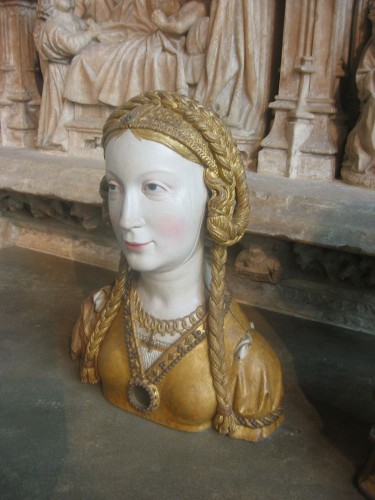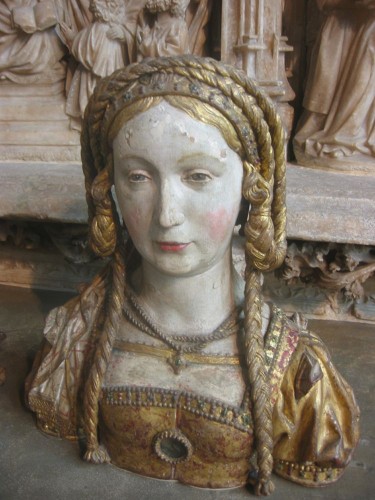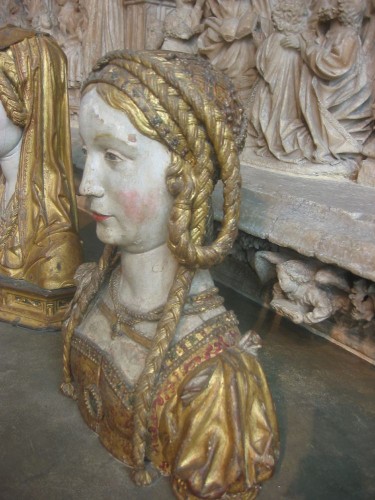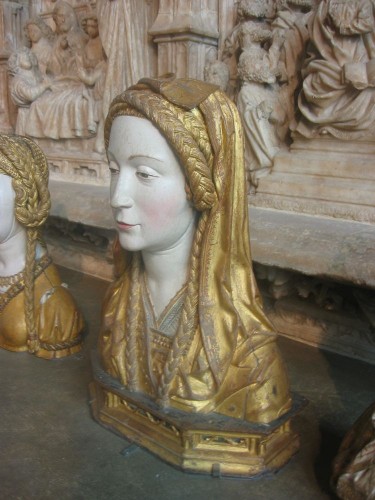These early 16th century reliquary busts of saints in the collections of the Cloisters both intrigued and repulsed me.
I love the women’s serene faces, their elaborate hairstyles and meticulously rendered clothes. I’m amazed by how precise the carving is, and how vivid the colours some 500 years later.
They are such beautiful, unique, examples of what was admired and desirable in women in late Renaissance Belgium.
At the same time, I can’t get past what they are: reliquary boxes. Containers for holding human remains: the skulls and other bones of saints. There are little doors in the top of the heads so that they could open the heads on feast days. I presume that the bones were removed long before the busts made it to the Cloisters, but I still have trouble adjusting my beliefs on how human remains should be treated with the attitudes and customs of the Renaissance Catholic Church.
It’s another example of how my aesthetic attraction to the past constantly makes me consider and question my modern beliefs and attitudes, and how they compare to historical beliefs and attitudes.





They are really pretty (I like the second one best).
How human remains like bones should be treated today is a very difficult ethic question.
But I think in a religious background it is quite different. It is more a question of tradition. Beeing from southern Germany I have absolutly no problem with saints remains beein on display (or even handling them myself), it’s just normal.
Those busts are actually quite “tame” (sorry I sometimes lack the appropriate words). You normally can’t see the remains at all! There is stuff like “Katakombenheilige” which are whole skeletons of saints wrapped in gold and silk. Or the “golden chamber” (Goldene Kammer) in St. Ursula in Cologne, where the upper parts of the walls are decorated with bones. Those seem a bit strange to us modern people and especially people from other countries.
It’s a difficult matter and discussions of how we should treat those remains and why can be discussed endlessly.
This got longer than I wanted 🙂
I didn’t include links because I feared someone would click them who would think it’s creepy or unethical to display human remains in such a fashion.
There are other interesting questions about how to treat human remains that are found as a result of archaeological investigation. For example, the surviving Manazan shirt from the Byzantine era was found on the remains of its last wearer, and is presently being displayed, bones and all, in a museum in Turkey.
Ergh. I’m not clicking on that link. Don’t want to see remains. Can’t get past my Polynesian attitudes!
There are many things about the earlier centurys that I find very beautiful (one example is the clothes) but I sometimes get jarred back into appreciating my century when I hear other things (like 17 century parents losing their only child to juvenile diabetes or some other treatable or curable disease.) There is good and bad to all ages. And sometime the good we imagine in another era is simply romantic ideals that aren’t all that accurate and sometime the bad in other ages is simply the prejudiced bias of our own culture that doesn’t reflect how the people living in that place and time felt about it. They may have liked or been indifferent to what offends us. Perspective is everything.
As an art history major with a particular emphasis on the Medieval and Renaissance eras, I can somewhat understand where the artists were coming from when they built these reliquaries. To Catholics then, and still today, the relics (body parts of a saint, something they touched, a part of their clothing) serve as a vessel in which their prayers reach the saint in Heaven. The saint in turn, acts as a mediator at the Last Judgement in the defense of the person. To them it was almost like having a lawyer in Heaven for them.
Even then I still have a hard time coming to terms that inside a pretty outer shell is, at least potentially, a part of a human body. It probably has something to do with our modern sensibilities, being somewhat more shielded from death than our previous counterparts. By that I mean that death was more prevalent then and we were far more “aware” and cognizant of it.
Well, that turned out longer than I planned.. 😀 But they are lovely regardless of what may be in them.
Em.
I found these to be breathtaking when I saw them in the cloisters. I didn’t know at the time that they were reliquaries (I was in a hurry at the time). Fascinating stuff.
As someone grown up in rural (catholic) Bavaria, reliquary boxes are nothing new or strange to me; I’m familiar with them in many many forms, some as beautiful as the ladies here; some just simple (well…simple…the catholic church never did anything simple^^) gold or silver boxes, sheaths or cylinders. There’s one in every church since it’s the custom here that the church has to house a reliquary of the Saint it’s dedicated to; though mostly the reliquaries are not on show. There is, however, in a town very near to my homeplace, a museum that has many reliquaries on display, including the head and arm of St John the Baptist ( a popular joke says that according to the known reliquaries, St John must have had three heads and seven arms). I saw all this stuff there as a child and was fascinated by it, and it left me absolutely immune to any zombie horror stuff *lol* Another good thing is, as you say, that the boxes often take the shape of busts and thus they make important evidence for both art and costume historians 🙂